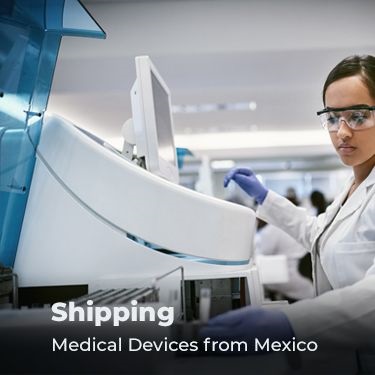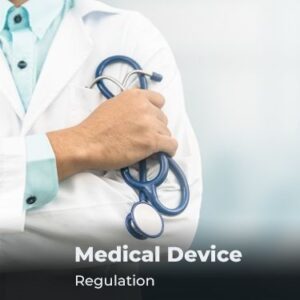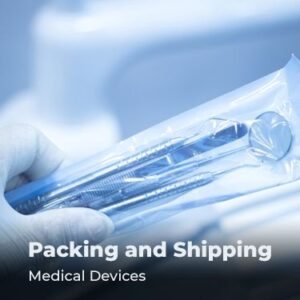
By
 Copy URL to Clipboard
Copy URL to Clipboard
If you’re interested in shipping medical devices from Mexico, then you probably know that the process is highly regulated. Government entities such as the Food and Drug Administration (FDA) and Customs and Border Protection (CBP) require importers to follow strict rules in the process of ensuring that imported medical devices comply with U.S. standards.
Key Takeaways
In this guide, we’ll show you the fundamentals involved in importing medical devices from Mexico to the U.S.
Table of Contents
Virtually any medical device you can think of can be manufactured by our neighbor to the south. Factories in Mexico exported over $22 billion worth of medical devices to the United States in 2023 alone. The definition for medical devices in Mexico is wide-reaching and encompasses substances, electronics, instruments, software, and other equipment that is used in healthcare.
These products include anything used to treat, diagnose, monitor, or prevent illnesses, as well as aesthetic and functional prosthetics used to correct disabilities or dysfunction. Devices involved in the alteration of anatomy and physiological processes, such as aesthetic implants, are also included in this definition.
In the table below, I’ve compiled some of the top medical device exports from Mexico to the U.S. from 2023.
| Commodity | Quantity Imported | Value in Thousands of USD |
| Ultraviolet or Infra-red Ray Apparatus | 121,353 kg | $35,585.99 |
| Patient Monitoring Systems | 37,122,600 | $941,504.91 |
| Syringes, With or Without Needles | 135,843,000 | $233,917.37 |
| Needles, Catheters, Cannulae, and the Like | 366,177,000 | $2,964,849.90 |
| Other instruments and appliances used in medical or veterinary practices | 1,111,820,000 | $7,342,786.13 |
These and other medical devices are regulated by an arm of the Mexican government called COFEPRIS.
Related: How to Find Manufacturers in Mexico
The Federal Commission for Protection Against Health Risks (COFEPRIS) is part of the Mexican Ministry of Health. This division is responsible for overseeing medical devices and In Vitro Diagnostics (IVD). Their chief goal is to protect consumers from potentially harmful medical devices.
The division can be considered Mexico’s equivalent of the FDA’s Center for Devices and Radiological Health (CDRH).
Specifically, COFEPRIS’ duties pertaining to medical devices include:
In addition to device-related duties, COFEPRIS also monitors hospitals and other health facilities.
The United States-Mexico-Canada Agreement (USMCA) is a trade agreement between the three countries to remove tariffs and other foreign trade barriers on certain commodities. These include medical devices.
Some of these changes are:
These policies also reduce border processing times and final costs for importers.
 Medical Device Regulation
Medical Device RegulationThe process for regulating medical devices in the United States is complicated, and there are many things you need to know about classifications, approval processes, and labeling to achieve compliance.
Before being exported from Mexico, medical devices must be classified into one of three different categories based on their potential risk according to FDA guidelines.
Some basic devices like bedpans and stethoscopes fall into a more generic Class I category which exempts them from premarket notification requirements.
With the exception of the previously mentioned generic items, medical devices marketed in the United States are subject to one of two premarket actions.
If the FDA determines that the device is allowed to enter the U.S. market, it will be granted approval, and you can move on to the next step.
Adhering to medical device labeling regulations from the FDA is an important part of preparing these goods for import into the U.S. To comply, all devices must meet a set of minimum requirements.
At the very least, all medical device labels must have:
Depending on the device, its class, and where it will be used, there may be more specific requirements to follow as well.
Failing to follow these labeling requirements could result in serious delays at the U.S. border. Your products could be seized, re-exported, or even destroyed.
 Packing and Shipping Medical Devices
Packing and Shipping Medical DevicesThe best practices for packing and shipping medical devices really depends on the type of medical device you’re shipping. As demonstrated earlier, the medical device industry is huge, and encompasses many different types of products.
Additionally, you’re going to need to know the specific processes for clearing customs for Mexico cross-border shipping.
Given the diverse nature of medical devices, shipping and handling procedures will vary greatly. Simple items like latex gloves or protective masks have correspondingly simple shipping needs: stack them on a pallet, wrap the shipment, and send it on its way.
However, other items have special requirements. Electronics, like pacemakers and hearing aids, need extra protection from moisture. Likewise, items like disinfectants, ointments, and burn treatments may require specific temperatures to be maintained during transit.
Failure to store and ship your medical devices correctly will most likely result in your product becoming unusable. The FDA doesn’t take chances with consumer health, so even if it doesn’t seem like there is anything wrong with your product after storing it improperly, it’s still likely to be denied entry.
Experienced third-party logistics companies can, ensure that your devices are shipped and stored at the correct temperature and humidity levels. Trusting one company with all of your logistics needs simplifies this complicated process and provides transparency at every stage of shipping and delivery.
Like any other imported goods, medical devices need to be accompanied by specific documents to clear customs.
These documents include:
A licensed customs broker can assist you with getting all the documents for your shipment in order. Brokers can also assist you with staying up to date on changing regulations, and handle all the paperwork on your behalf.
Related: How to Ship Freight to Mexico
 Medical Device Supply Chain
Medical Device Supply ChainWhen it is time to move the products, they are loaded onto freight trucks and taken to a Port of Entry to cross the border. These ports can be found in places like Laredo, El Paso, and San Ysidro.
Medical devices manufactured in Mexico start in special assembly plants known as maquiladoras, which are typically American-owned operations located near the U.S. border. These plants import raw materials and components, assemble the parts into finished products, and then export them into the U.S.
When the products reach the U.S., they are moved into a warehouse or delivered to their final destination.
Related: What Are Maquiladoras and Where Are They Located?
The Federal Motor Carrier Safety Administration (FMCSA) dictates that all carriers moving over the border must be licensed and certified to operate in both the U.S. and Mexico.
When selecting a freight service for shipping medical devices from Mexico, it is important to find a carrier with a reputation for successful deliveries. Monitoring your freight during a cross-border shipment can be difficult, so you should work with a carrier that will be open and willing to communicate with you transparently.
Shipping medical devices from Mexico doesn’t have to be a difficult task. At R+L Global Logistics, our multilingual staff has over 30 years of cross-border experience, so you can rest easy knowing that your shipment is in good hands.
Our services include:
If you’re ready to ship medical devices from Mexico, give us a call at (866) 335-0495 or contact us online. We’ll make sure your shipment reaches its destination in good health.
 Copy URL to Clipboard
Copy URL to Clipboard
